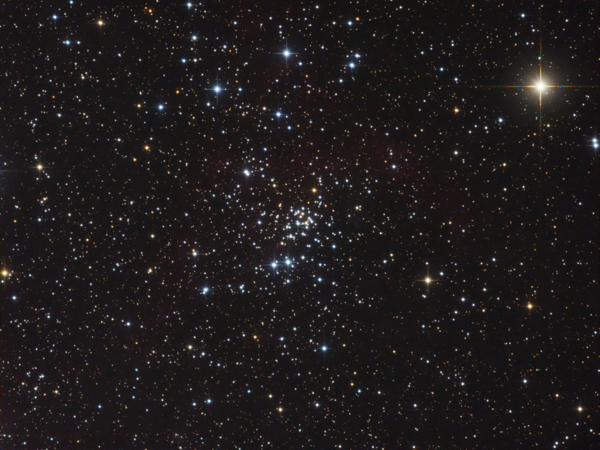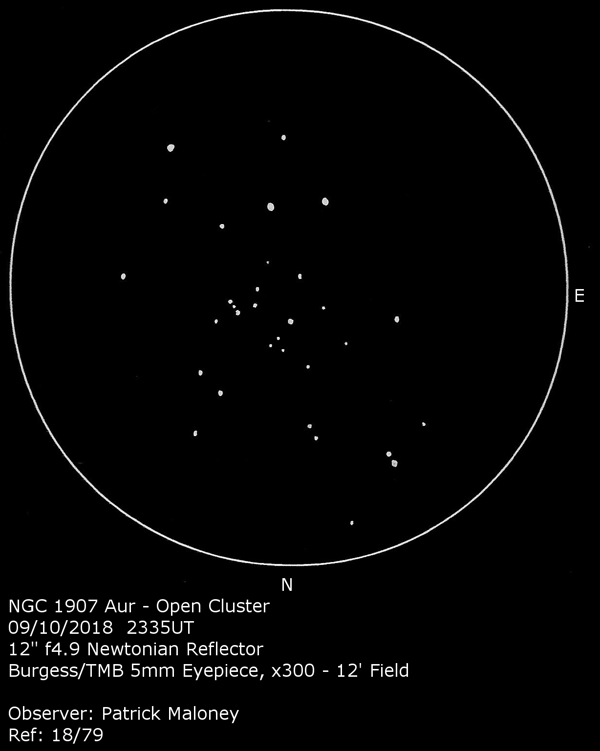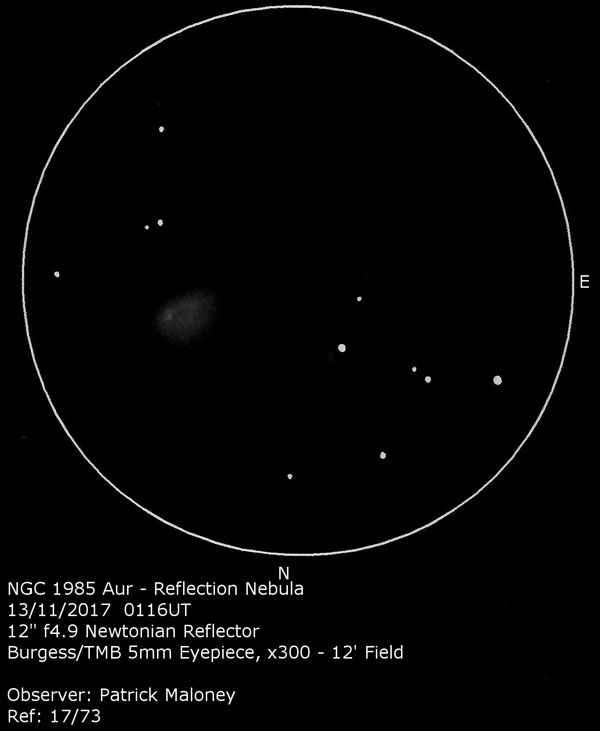NGC 1907 and NGC 1985 in Auriga
December 2022 - Nebula and Cluster of the Month
The bright winter constellations are now dominating the evening sky. By the middle of the month, the bright yellow star Capella, α Aurigae, shines down from a vantage point close to the zenith. Auriga straddles the galactic equator, and so is full of interesting clusters and nebulae. Both this month’s objects are in Auriga.
We’ll start with the open cluster, NGC 1907. It was discovered, predictably, by William Herschel on 17 January 1787, when he described it as a pretty compressed cluster of small stars, 4’ diameter.
He assigned it to his seventh class (‘pretty much compressed clusters of large or small stars’) as number 39. This description carried on more-or-less unchanged into the NGC, with the addition that the stars range from ninth to twelfth magnitude – something of an overestimate.

NGC 1907 lies just about 33’ from the centre of the bright open cluster M38 and is often seen sharing an image with that cluster. From M38 move half a degree south and a nudge to the west. It provides an interesting contrast with its brighter and splashier neighbour.
I made my first observation of NGC 1907 with a 4.5” (112mm) reflector way back in 1986. On that night, I noted that the cluster appeared fairly small and was unresolved but heavily mottled. I also noted its clear elongation NW-SE. A very similar observation, made by Patrick Brennan with a 6” (150mm) reflector can be seen in the Webb Society Deep-Sky Observer’s Handbook Volume 3, Open and Globular Clusters.

I’ve revisited the cluster a few times since then, making observations in 2013 and 2018. In 2018 I made my second drawing of the object, reproduced below.

I plotted over 30 stars on this observation, from magnitude 9 to about 14.5. Most sources list the brightest star as eleventh magnitude, so presumably the brighter stars have been shown to be foreground objects.
Moving slightly less than 4° southeast of NGC 1907 will bring you to our second object for December, a small reflection nebula listed as NGC 1985. It lies about a third of the way along the line from β Tauri and θ Aurigae. Another Herschel discovery, he first saw it on 13 November 1790 and described it as very faint, very small, round, brighter in the middle.
He placed it in his third class (‘very faint nebulae’) as number 865.

NGC 1985 is a reflection nebula but has in the past been incorrectly identified as a planetary nebula, having been included in the Perek-Kohoutek catalogue as PK 176+0.1, though it has been removed from the updated ESO-Strasbourg catalogue.
The entry in the Deep Sky Field Guide to Uranometria 2000.0 is unedifying. It gives the RA and Dec. of the object but nothing else. The major and minor axes are approximately 1’ and 45”, depending on how deep the image is. The type is R.
NGC 1985 can be a challenging object, especially to those of us blighted by bright skies. Unusually for a reflection nebula, it has an oft-quoted magnitude, 12.8. However, it’s a fairly compact object, meaning that its surface brightness is relatively high.
I made two failed attempts to view this object, in 2014 and again in 2017. On both occasions, my notes read ‘Field positively identified. Not seen.’ This means that I had matched the view through my eyepiece with a sufficiently detailed chart of the area, so I know I was looking in the right place. Then, just two weeks after my second failed attempt, I got it. I was at the same location, using the same telescope, and yet somehow, it was now easy to see. The transparency was much better that night, and I recorded a naked-eye limiting magnitude of 5.2, as opposed to 4.0 on the previous occasion.

I found that it was small but visible to direct vision. There was a bright spot with an almost triangular-shaped fan of nebulosity stretching away from it. I also noted that the view was better without a UHC filter.
On this last issue, the observing notes in the Night-Sky Observer’s Guide made from observations with a 12/14” telescope reads Faint but visible without filters.
| Object | RA | Dec | Type | Magnitude |
|---|---|---|---|---|
| NGC 1907 | 05h 28’ 05” | +35° 19’ 32” | Open cluster | 8.2 |
| NGC 1985 | 05h 37’ 48” | +31° 59’ 20” | Reflection nebula | 12.8 |